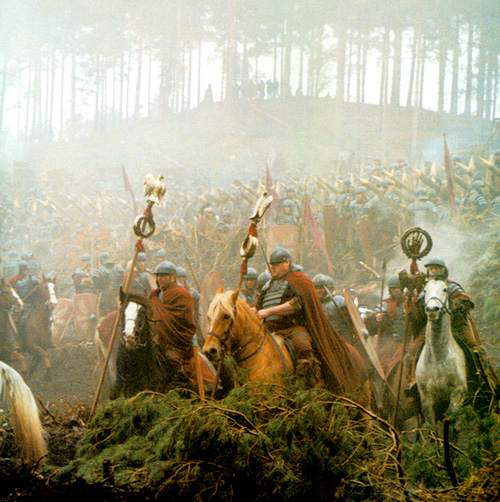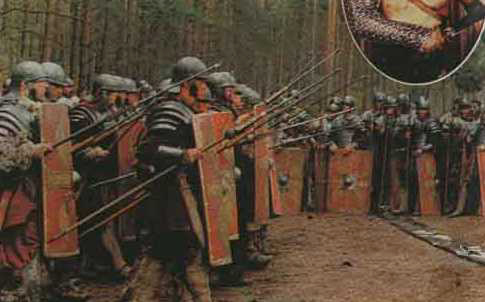Early Army's and Reforms
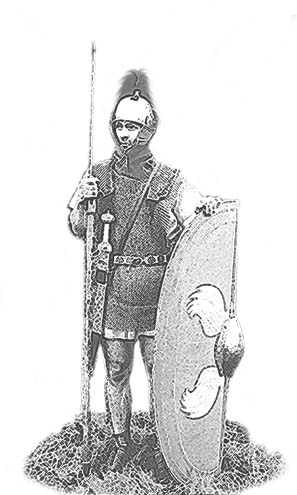
The Early Army was a replacement for phalanx which were originally created by the Greeks. The Early Army formed around the 4th century BC when the Roman formed the Latin league which contrived the idea of a new type of army. This army would be the envy of lesser empires and the upper hand in battle. This new army had three different types of soldiers that were categorized by rows, apposed to the Phalanx form of army which were maid solely of phalanx (spear men with shields). These units were the hastati, principes, triarii, rorarii and accensi that formed the army. The average soldier wore armor and a rectangular shield called scutum. This army was contrived of 15 groups of leves (inexperienced soldiers) which had 20 people in each group amounting to 300 people. The hastati and the principes had 15 groups of 60 that totaled to 900 people each. Then there were 45 other different groups that had 60 people in each which totaled 2700 people. One army was about 4800 soldiers strong. The original strategy of this army was to have five lines that acted as safety barriers. The first line would lead the attack against the enemy and if they were routed, defeated or needed to retreat for any reason the second line would advance and attack while the first line regrouped. The third line would stay down behind the second so that if the second line failed the third line could suprise the enemy and this would be the Romans last line of defense before defeat. Scipio Africanus was a great contributor to the Roman Army. He made a reform that changed the way the Romans fought. Instead of attacking the enemy in "waves" with one line attacking after the other, Scipio trained his soldiers hard so that they would be prepared for strategic battle that was more a game of chess than a standard attack generals would always use. During the second century the Roman army had revolutionary changes and new inventive armor. These men were well equipped with either bronze plated armor or chain mail. The soldiers also wore a feather plum that measured 18 inches so that they would look taller and more intimidating. They were also equipped with a small spear that was well made, but bent on impact so that the enemy could not throw the spears back. The size of each unit also increased anywhere from 120 to 140 soldiers. Not only did the infantry increase, but the Cavalry did too. The cavalry had ten squadrons out of every 300 cavalryman. During this time period they often looked to allies for a dropped enthusiasm in their own empire to enlist in the army. Marius, like Scipio, was another great reformer of the army. He improved the weapons to be more effective in battle and also recruit the soldiers differently. The poor people would have to enlist in the army much longer than the standard six years. Since there were so many poor soldiers in the army, Marius made an army solely from the poor population therefore increasing the average skill in the other armies. Marius also made the army a place for a career, in turn making Rome's army a paid profession.
Classic Army
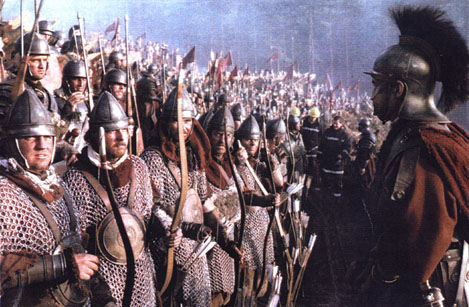
The "classic army" was known to be the army of Augustus. This army was called the classic army because it was the army at the top of its height. It was the pride of the Roman Empire and is the army that is most frequently talked about when it comes to military in the Roman Empire. This army was the greatest of all the other Roman armies in the past. It consisted of 28 legions that had approximately 6000 soldiers. That would total the Roman army to 168,000. Caesar made other changes, such as having the time of service chnage from 6 years to 16 years of full service and 4 years of part-time service. Soldiers who carried a great amount of supplies were called 'Maurius' Mules'. They were calculated to have carried 66 lb of equiptment which matches the max amount carried by soldiers today which is about 66 lb. However with 16 days of rations the supplies weighed up to 93lb. The classic army had a much more orginized structure to their army. One Contubernium was eight men, and ten men were Contubernia, which made up a century that consited of eighty men. Two Centuries made up one Maniple which was 160 men.Six centuries is one Cohort or 480 men. Ten Cohorts plus 120 horsemen is a Legion which is 5240 soldiers. The battle order and strategy of this army is a little different. It is made up of two lines with 5 cohorts in each line.
Army Camps
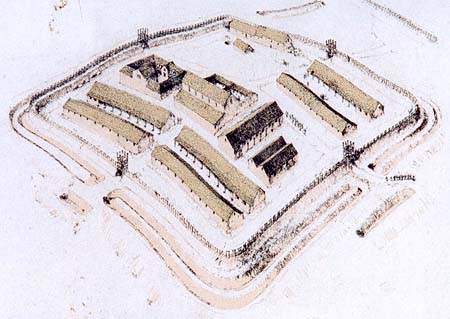
Army camps such as the one above were the barracks for the Legions and their training. However when on a military campaign the soldier must stop and make camp. First the engineers scout ahead for a good place to stop. Then they put up a pallaside wall and tents for them to sleep in. The tents had room for about 8.Click the link "map" bellow to show the layout of a standard camp. Map
The Navy

The Romans were never famous for being ship builders. They never had a very good navy and never knew how to build ships. Instead they coppied their ships off of captured carthiginean boats. The Romans were so uninterested with the sea that their army even controled their navy. The Romans eventually invented their own type of ship that would get them close enough to an enemy ship so they could fight hand to hand. The Romans even went as far as trusting their allies to protect them in the seas becuase they could not maintain a fleet.

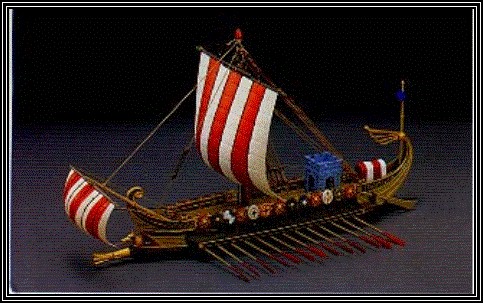
Seige Warfare

Another seige weapon is the seige tower. It was used to attack city's or forts and not be counter-attacked from above. It gave Archers and seige weapons range so that they could pick off people on city walls. This height advantage provided a defensive and offensive advantage.

Tactics
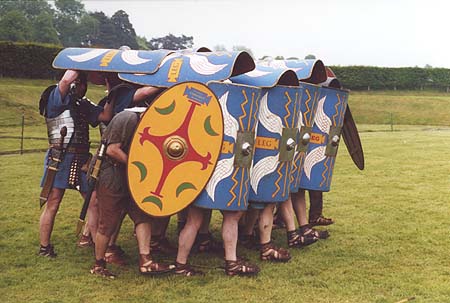 There were many different tactics that the Romans utilized in the army.
One of the most effective tactics was the tortoise (shown above). This is
a defensive position that sheilded the legions from an attack of arrows
or balistas. Another tactic was the wedge. The wedge was an offensive position
that was used when charging towards the enemy. As shown below, the
wedge forms a triangle that was used to "spear" the front line of the enemy
and split the army. This was one of the most important formations that the
Romans used.
There were many different tactics that the Romans utilized in the army.
One of the most effective tactics was the tortoise (shown above). This is
a defensive position that sheilded the legions from an attack of arrows
or balistas. Another tactic was the wedge. The wedge was an offensive position
that was used when charging towards the enemy. As shown below, the
wedge forms a triangle that was used to "spear" the front line of the enemy
and split the army. This was one of the most important formations that the
Romans used.  Skirmish formation was a loose formation that spread out the legions and
had every other man staggared. This way they could cover more territory but
still have a relitivley strong force. Even if the opposing force did penetrate
there would be more lines stacked behind it. The skirmish is shown below.
Skirmish formation was a loose formation that spread out the legions and
had every other man staggared. This way they could cover more territory but
still have a relitivley strong force. Even if the opposing force did penetrate
there would be more lines stacked behind it. The skirmish is shown below.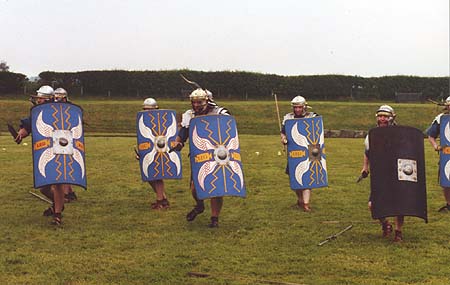 Another type of formation is to repel cavalry. This formation has
the spearmen neel down while they have their sheilds and spear facing foward.
This creates a barrier so that the cavalry could not penetrate which was
a large factor in many battles. This formation is shown below.
Another type of formation is to repel cavalry. This formation has
the spearmen neel down while they have their sheilds and spear facing foward.
This creates a barrier so that the cavalry could not penetrate which was
a large factor in many battles. This formation is shown below.
The greatest defensive position was the orb. Shown below, the men form a complete circle or "orb". This tactic was used when a unit was detached from its main body the soldiers are surrounded. This was vital in making a defensive stance and doing the best out of what they had so they could maximize their kill-loss ratio.
